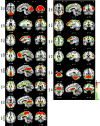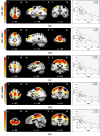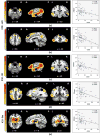Resting-state functional magnetic resonance imaging in clade C HIV: within-group association with neurocognitive function
- PMID: 28971331
- PMCID: PMC5780332
- DOI: 10.1007/s13365-017-0581-5
Resting-state functional magnetic resonance imaging in clade C HIV: within-group association with neurocognitive function
Abstract
Neuroimaging abnormalities are common in chronically infected HIV-positive individuals. The majority of studies have focused on structural or functional brain outcomes in samples infected with clade B HIV. While preliminary work reveals a similar structural imaging phenotype in patients infected with clade C HIV, no study has examined functional connectivity (FC) using resting-state functional magnetic resonance imaging (rs-fMRI) in clade C HIV. In particular, we were interested to explore HIV-only effects on neurocognitive function using associations with rs-fMRI. In the present study, 56 treatment-naïve, clade C HIV-infected participants (age 32.27 ± 5.53 years, education 10.02 ± 1.72 years, 46 female) underwent rs-fMRI and cognitive testing. Individual resting-state networks were correlated with global deficit scores (GDS) in order to explore associations between them within an HIV-positive sample. Results revealed ten regions in six resting-state networks where FC inversely correlated with GDS scores (worse performance). The networks affected included three independent attention networks: the default mode network (DMN), sensorimotor network, and basal ganglia. Connectivity in these regions did not correlate with plasma viral load or CD4 cell count. The design of this study is unique and has not been previously reported in clade B. The abnormalities related to neurocognitive performance reported in this study of clade C may reflect late disease stage and/or unique host/viral dynamics. Longitudinal studies will help to clarify the clinical significance of resting-state alterations in clade C HIV.
Keywords: Global deficit scores (GDS); Human immunodeficiency virus (HIV); Neurocognitive deficits; Resting-state functional connectivity (RSFC); Resting-state functional magnetic resonance imaging.
Conflict of interest statement
The authors, Lindie du Plessis, Robert Paul, Jackie Hoare, Dan Stein, Paul Taylor, Ernesta Meintjes and John Joska, declare that they have no conflict of interest.
Figures



Similar articles
-
HIV infection across aging: Synergistic effects on intrinsic functional connectivity of the brain.Prog Neuropsychopharmacol Biol Psychiatry. 2019 Jan 10;88:19-30. doi: 10.1016/j.pnpbp.2018.06.006. Epub 2018 Jun 12. Prog Neuropsychopharmacol Biol Psychiatry. 2019. PMID: 29906495
-
Intrinsic network connectivity abnormalities in HIV-infected individuals over age 60.J Neurovirol. 2016 Feb;22(1):80-7. doi: 10.1007/s13365-015-0370-y. Epub 2015 Aug 12. J Neurovirol. 2016. PMID: 26265137 Free PMC article.
-
Decreased regional homogeneity and increased functional connectivity of default network correlated with neurocognitive deficits in subjects with genetic high-risk for schizophrenia: A resting-state fMRI study.Psychiatry Res. 2019 Nov;281:112603. doi: 10.1016/j.psychres.2019.112603. Epub 2019 Oct 7. Psychiatry Res. 2019. PMID: 31622873
-
Neuroimaging studies of resting-state functional magnetic resonance imaging in eating disorders.BMC Med Imaging. 2024 Oct 7;24(1):265. doi: 10.1186/s12880-024-01432-z. BMC Med Imaging. 2024. PMID: 39375605 Free PMC article. Review.
-
Functional connectivity and the sleep-deprived brain.Prog Brain Res. 2019;246:159-176. doi: 10.1016/bs.pbr.2019.02.009. Epub 2019 Mar 21. Prog Brain Res. 2019. PMID: 31072560 Review.
Cited by
-
Whole-brain computational modeling reveals disruption of microscale brain dynamics in HIV infected individuals.Hum Brain Mapp. 2021 Jan;42(1):95-109. doi: 10.1002/hbm.25207. Epub 2020 Sep 17. Hum Brain Mapp. 2021. PMID: 32941693 Free PMC article.
-
Reversible large-scale network disruption correlates with neurocognitive improvement in HIV-associated minor neurocognitive disorder with combined anti-retroviral therapy intensification: a prospective longitudinal resting-state functional magnetic resonance imaging study.Neurol Sci. 2023 Sep;44(9):3261-3269. doi: 10.1007/s10072-023-06783-z. Epub 2023 Apr 13. Neurol Sci. 2023. PMID: 37052787
-
Movement-related beta and gamma oscillations indicate parallels and disparities between Alzheimer's disease and HIV-associated neurocognitive disorder.Neurobiol Dis. 2023 Oct 1;186:106283. doi: 10.1016/j.nbd.2023.106283. Epub 2023 Sep 6. Neurobiol Dis. 2023. PMID: 37683957 Free PMC article.
-
Deep Phenotyping of HIV Neurocognitive Complications Among Individuals Residing in High-Income Countries.Curr Top Behav Neurosci. 2021;50:245-269. doi: 10.1007/7854_2020_185. Curr Top Behav Neurosci. 2021. PMID: 33442841
-
Hub disruption in HIV disease and cocaine use: A connectomics analysis of brain function.Drug Alcohol Depend. 2024 Oct 1;263:112416. doi: 10.1016/j.drugalcdep.2024.112416. Epub 2024 Aug 21. Drug Alcohol Depend. 2024. PMID: 39197360
References
-
- Ances BM, Roc AC, Wang J, Korczykowski M, Okawa J, Stern J, Kim J, Wolf R, Lawler K, Kolson DL, Detre JA. Caudate blood flow and volume are reduced in HIV+ neurocognitively impaired patients. Neurology. 2006;66(6):862–6. doi: http://dx.doi.org/10.1212/01.wnl.0000203524.57993.e2. - DOI - PubMed
-
- Ann HW, Jun S, Shin NY, Han S, Ahn JY, Ahn MY, Jeon YD, Jung IY, Kim MH, Jeong WY, Ku NS. Characteristics of Resting-State Functional Connectivity in HIV-Associated Neurocognitive Disorder. PloS one. 2016;11(4):0153493. https://doi.org/10.1371/journal.pone.0153493. - DOI - PMC - PubMed
-
- Aylward EH, Henderer JD, McArthur JC, Brettschneider PD, Harris GJ, Barta PE, Pearlson GD. Reduced basal ganglia volume in HIV-1-associated dementia Results from quantitative neuroimaging. Neurology. 1993;43(10):2099–2099. doi: http://dx.doi.org/10.1212/WNL.43.10.2099. - DOI - PubMed
-
- Antinori A, Arendt G, Becker JT, Brew BJ, Byrd DA, Cherner M, Clifford DB, Cinque P, Epstein LG, Goodkin K, Gisslén M, Grant I, Heaton RK, Joseph J, Marder K, Marra CM, McArthur JC, Nunn M, Price RW, Pulliam L, Robertson KR, Sacktor N, Valcour V, Wojna VE. Updated research nosology for HIV-associated neurocognitive disorders. Neurology. 2007;69(18):1789–1799. doi: http://dx.doi.org.ezproxy.uct.ac.za/10.1212/01.WNL.0000287431.88658.8b. - DOI - PMC - PubMed
-
- Beckmann CF, Mackay CE, Filippini N, Smith SM. Group comparison of resting-state FMRI data using multi-subject ICA and dual regression. Neuroimage. 2009;47(Suppl 1):S148.
Publication types
MeSH terms
Grants and funding
LinkOut - more resources
Full Text Sources
Other Literature Sources
Medical
Research Materials

